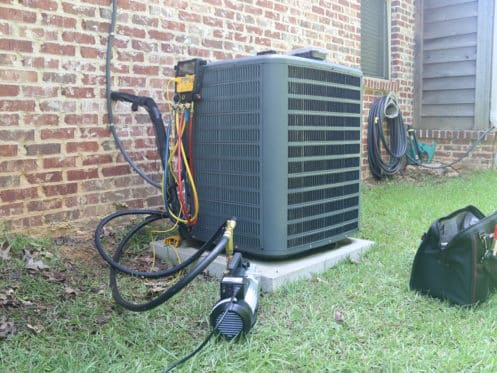The wildly changing prices energy prices in California can make heating or cooling your home difficult. Thankfully, with the right knowledge, you have a lot of control over how much energy your system consumes. Consider these 11 tips for reducing your heating and cooling costs throughout the year.
1. Change or Clean Your Air Filter
One of the most important parts of lowering your energy costs is keeping your air filter clean so that air can flow through it properly. Without the right amount of air moving through your system, you’ll extend your heating and cooling cycles and increase the strain on your system, causing it to consume more energy.
If you have a central air system, plan to check your filter monthly. You’ll likely need to change the common filters between every 30 and 90 days.
If you have a ductless mini-split system, you’ll need to wash the filter that’s in each air handler at least every 30 days. Be sure to let it dry completely before reinstalling it. If you have multiple air handlers throughout your home, you may want to rotate cleaning one each week so that you only have one handler to clean each time.
2. Get Bi-Annual HVAC Maintenance
Maintenance is nearly as important as keeping a clean air filter. When you get routine maintenance, a technician will clean the system so that there aren’t internal airflow restrictions. They’ll also test for components that aren’t working properly, preventing additional strain and wear on the rest of the system. Finally, they’ll check and tighten electrical connections to ensure there isn’t more resistance than needed, which can push up energy consumption.
3. Keep Vents Open and Clear
Aside from a clogged air filter, one of the most common airflow restrictions comes from either closed or blocked vents. Without the proper amount of air coming from supply vents and into return vents, the conditioned air won’t circulate properly. Not only does this reduce your home’s comfort, but it also drives up energy consumption through extended heating and cooling cycles. Ensure that every supply vent is open and there are at least six inches above and around the vent to allow adequate airflow and air pressure.
4. Utilize Ceiling Fans
Ceiling fans are an underappreciated tool when trying to control your home’s HVAC energy costs. While they won’t reduce the temperature of the air over the summer, they will make it feel cooler. This makes your home feel more comfortable even when you raise the temperature on your thermostat a few degrees, reducing your energy consumption.
Further, over the winter a properly rotating ceiling fan will help push the warm air down from the ceiling into the living space. This helps reduce heating cycle length and make your home more comfortable. Make sure your fan rotates counterclockwise in the summer and clockwise in the winter.
5. Manage Your Shades
Windows are exceptionally important for allowing natural light in, which both creates a pleasant ambiance and helps with mental health. However, windows can also play an important role in managing your home’s HVAC energy consumption.
Keep your shades closed during the summer when the sun is shining directly on a window. You can keep them open when the sun is facing a different part of the house. Conversely, keep them open during the winter to allow some natural thermal heating to take some strain off your HVAC system.
6. Leverage Thermostat Programs
Modern digital thermostats are both more accurate than older mechanical models but also offer better energy management features. The Department of Energy suggests you can reduce your energy consumption by about 10% by simply changing the temperature when you’re not home if you use a standard AC and furnace.
The idea is to increase the temperature during the summer by 7 to 10 degrees while you’re not home and decrease it by the same amount during the winter. Thermostat programs allow the system to automatically make this adjustment so that you don’t have to try to remember. If you get a smart thermostat, it can help you develop these programs based on your usage habits. If you have a remote access smart thermostat, you can always adjust it from your mobile device if you have a hiccup to your normal schedule.
7. Stay On Top of Outside Maintenance
Maintaining the area around your outside unit is incredibly important for your air conditioner or heat pump. Both units must be able to draw air through the coil to allow heat transfer to and from the circulating refrigerant. If anything inhibits that airflow you’ll reduce your system’s efficiency, driving up your energy consumption. The industry recommendation is to keep at least two feet horizontally around the unit clear and five feet above the unit.
8. Seal Your Ducts
You can lose a lot of energy through leaky ducts. They can both allow conditioned air out so that it doesn’t arrive at its intended area of your home in addition to allowing unconditioned air in. The result is extended heating and cooling cycles for central ducted systems. It’s recommended you have your ducts evaluated every 10 years to see if they need sealing or better insulation.
9. Improve Indoor Air Quality
Poor indoor air quality increases how quickly your air filter will clog, increasing your system’s strain and wear. Depending on your situation, you may want to explore a few options to improve your indoor air quality and reduce that strain. Some homes may benefit from better humidity control, ideally keeping it between 30% and 50%. Other homes may need to explore additional filtering, purification, or air-scrubbing devices. Work with an indoor air quality specialist to find the right solutions for your home.
10. Check Your Insulation
Without the proper insulation, your home will easily transfer heat between the air inside your home and the air outside. To prevent this, have your home’s insulation checked at least every 5 to 10 years, or if you think there’s been damage to the insulation. In southern California, the minimum recommended insulation in your attic is R30, which is about 8.25 inches of standard fiberglass batt insulation.
11. Get Repairs Quickly
When you discover your HVAC system has a problem that requires repair, get it taken care of quickly. Delaying repairs allows the entire system to run with increased strain. Not only does this add more wear to your system, but it can also drive up energy consumption, depending on the faulty component. When you get routine maintenance, a technician may identify problems very early, allowing little to no additional energy consumption.
Affordable Air & Heating has been meeting the demand for home comfort around Lancaster for more than 25 years. Our team excels in providing trusted heating and AC maintenance, repair, and installation together with indoor air quality solutions, whole-home insulation, duct replacement, and thermostat installation. Call to schedule your heating or cooling maintenance or repair visit with one of our expert technicians today.




